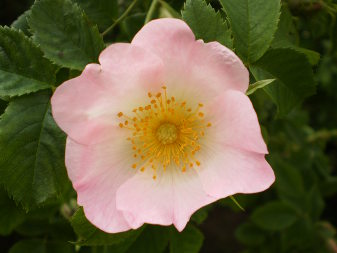
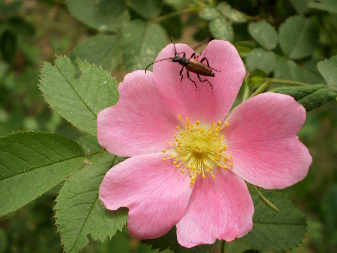
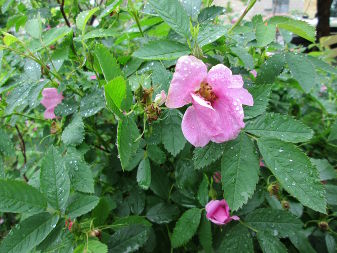
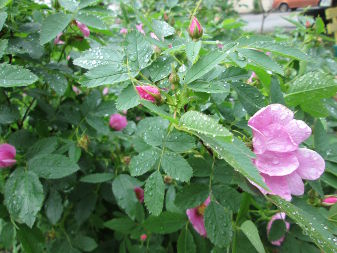
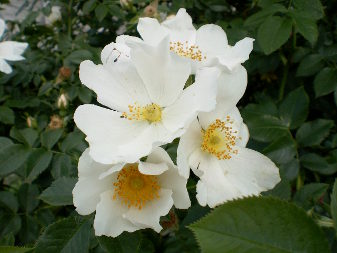
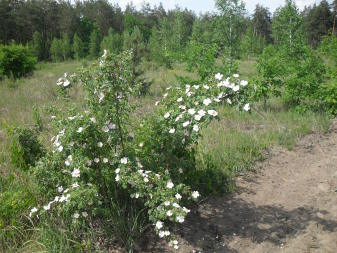
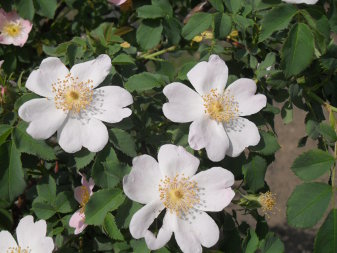
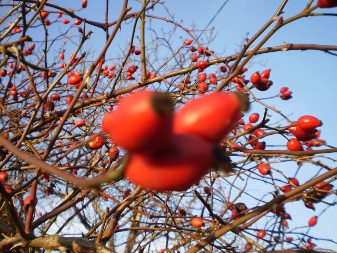
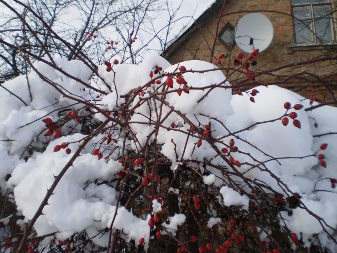
Rose (Rosa), fam. Rosaceae.
There are several species in the city and occasionally in the forest, the classification of which is confusing and ambiguous. It is possible to distinguish the Dog-rose (Rosa canina): flowers with weak smell and pale color, the ripe fruit are usually free from sepals. Beach or Japanese Rose (Rosa rugosa): bright flowers, large fruits, high density of spikes. Cinnamon Rose (Rosa majalis): bright and very fragrant flowers, and the fruits have the sepal residues standing upright.
The fruits (rosehips) are a natural vitamin concentrate. Most fresh fruit and vegetables besides the vitamin C also have the ascorbate oxidase enzyme, that oxidates and thus destroys the vitamin C during cutting, storage, drying or other processing methods. Amazingly, the rosehips are almost completely devoid of this unwanted enzyme. However, the concentration of vitamin C in different rose species may vary many times. In high-vitamin species (R. rugosa, R. majalis) the residues of sepals usually stand upright on the fruits; but in relatively low-vitamin species (R. canina), the sepals are bind down and nestle along the fruit walls, or drop off completely. If you meet wild rose bushes in the forest in autumn, or buy the already picked fruits in the market, you can use this distinctive feature. The rosehips are dried in an oven at 80 degrees Celsius, and should not become black.
The decoction of rose fruits or roots is a multivitamin, choleretic, weak diuretic, hypotensive remedy, promotes red blood cells formation, strengthens the blood vessel walls, enhances appetite. Long-term consumption is not desirable; also, the rosehips are not recommended for those with varisosis. The rosehips syrups, sold in many stores, which contain too much harmful sugar, should be avoided.
The petals of the rose flowers are also edible.
Dog-rose (Rosa canina):
Beach Rose (Rosa rugosa):
Cinnamon Rose (Rosa majalis):
Garden hybrid double-flowered roses – possibly, Rosa damascena:
Sometimes, strange fluffy formations on the rose bushes can be noticed. The tiny hymenoptera insects gall wasps (gallflies, Cynipidae) pierce the leaves with their ovipositors and lay their eggs inside. The leaf tissue irritates and grows abnormally, covering from the outside with numerous spikes, looking like moss. The so-called bedeguar galls form. If you can a gall, you may see several sections inside. Each of them is inhabited by a bent gall wasp larva. In autumn they are in a pupa stage, and by the beginning of the next summer they become adult (imago) gall wasps.